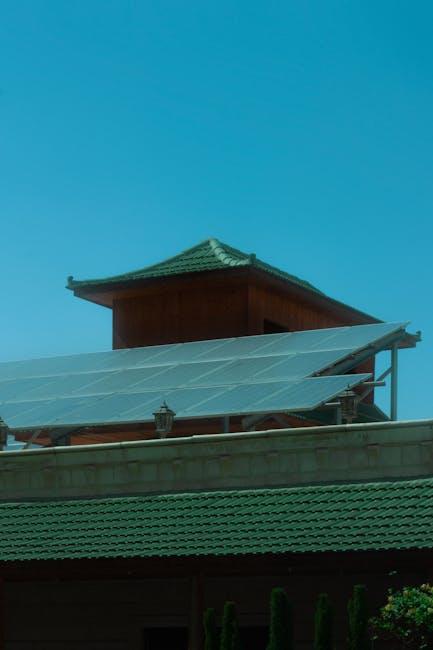Images Of Solar Panels On A Roof
Solar panels have become a common sight on rooftops across the globe, symbolizing a shift towards renewable energy and sustainability. As more homeowners and businesses recognize the benefits of solar energy, the images of solar panels on roofs tell a story of innovation, environmental consciousness, and economic savings. In this article, we will explore the various aspects of solar panels, including their types, benefits, installation processes, and the impact they have on our environment and economy.
The Rise of Solar Energy
In recent years, solar energy has gained significant traction as a viable alternative to traditional energy sources. This shift is driven by several factors:
- Environmental Concerns: With climate change becoming a pressing issue, many are looking for ways to reduce their carbon footprint.
- Economic Benefits: Solar energy can lead to substantial savings on electricity bills and increase property value.
- Technological Advancements: Improvements in solar technology have made panels more efficient and affordable.
Types of Solar Panels
When considering solar panels for your roof, it’s essential to understand the different types available. Each type has its unique features and benefits:
- Monocrystalline Solar Panels: Known for their high efficiency and sleek appearance, these panels are made from a single crystal structure. They tend to perform better in low-light conditions.
- Polycrystalline Solar Panels: Made from multiple crystal structures, these panels are generally less expensive but slightly less efficient than monocrystalline panels.
- Thin-Film Solar Panels: These panels are lightweight and flexible, making them suitable for various applications. However, they usually have lower efficiency rates compared to crystalline panels.
Benefits of Installing Solar Panels
Installing solar panels on your roof comes with numerous advantages that extend beyond just saving money on energy bills:
- Reduced Electricity Bills: By generating your own electricity, you can significantly lower your monthly utility costs.
- Increased Property Value: Homes with solar panels often sell for more than those without, making them a smart investment.
- Tax Incentives and Rebates: Many governments offer financial incentives for solar panel installation, making it more affordable.
- Energy Independence: Solar energy allows homeowners to rely less on the grid, providing a sense of independence and security.
- Environmental Impact: Solar energy is clean and renewable, helping to reduce greenhouse gas emissions and combat climate change.
How Solar Panels Work
Understanding how solar panels function can help demystify the technology behind them. Here’s a simple breakdown:
- Photovoltaic Cells: Solar panels are made up of photovoltaic (PV) cells that convert sunlight into electricity.
- Inverter: The electricity generated by the panels is in direct current (DC) form. An inverter converts this to alternating current (AC), which is used in homes.
- Energy Storage: Some systems include batteries to store excess energy for use during cloudy days or at night.
- Grid Connection: If your system produces more energy than you use, you can often sell the excess back to the grid.
Installation Process
Installing solar panels on your roof involves several steps. Here’s what you can expect:
- Consultation: A solar provider will assess your home’s energy needs and roof suitability.
- Design: A customized solar system design will be created based on your energy consumption and roof layout.
- Permitting: Necessary permits will be obtained from local authorities before installation begins.
- Installation: The solar panels will be installed on your roof, along with the inverter and any necessary wiring.
- Inspection: After installation, an inspection will ensure everything is up to code and functioning correctly.
- Activation: Once approved, your system will be activated, and you can start generating solar energy!
Common Misconceptions About Solar Panels
Despite the growing popularity of solar energy, several misconceptions still exist. Let’s debunk some of them:
- Solar Panels Are Too Expensive: While the initial investment can be high, the long-term savings and incentives often outweigh the costs.
- They Only Work in Sunny Areas: Solar panels can still generate electricity on cloudy days, although at reduced efficiency.
- Maintenance Is a Hassle: Solar panels require minimal maintenance, typically just occasional cleaning and inspections.
- They Are Not Aesthetically Pleasing: Modern solar panels come in various designs and colors, making them more visually appealing than ever.
The Environmental Impact of Solar Panels
Solar panels play a crucial role in reducing our reliance on fossil fuels and decreasing greenhouse gas emissions. Here’s how they contribute to a healthier planet:
- Reduction in Carbon Footprint: By using solar energy, households can significantly lower their carbon emissions.
- Conservation of Resources: Solar energy is renewable and abundant, reducing the need for finite resources like coal and oil.
- Improved Air Quality: Transitioning to solar energy helps decrease air pollution, leading to better health outcomes for communities.
Future of Solar Energy
The future of solar energy looks bright, with ongoing advancements in technology and increasing adoption rates. Here are some trends to watch:
- Improved Efficiency: Research is focused on developing more efficient solar cells that can capture more sunlight.
- Energy Storage Solutions: Innovations in battery technology will enhance the ability to store solar energy for later use.
- Integration with Smart Homes: Solar systems will increasingly be integrated with smart home technology for better energy management.
- Community Solar Projects: More communities are exploring shared solar projects, making solar energy accessible to those who cannot install panels on their own roofs.
Conclusion
<p




